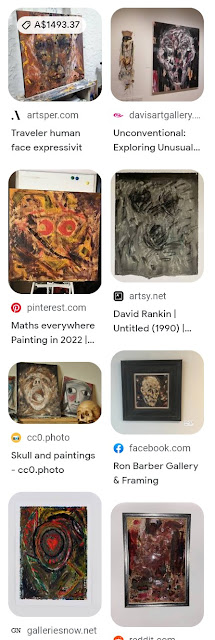My birthday inspired friends I know to take notice and one woman came over to cook fish and beetroot salad. The next day another friend talked about Georgia O’Keeffe as I’d been reading a biography of the American artist, it was a broad-ranging discussion during which we aimed our minds at diverse things such as women’s rugby league and the Finnish president with part of the discussion centring around the use of art.
Basia signed off as it was getting to the end of the day in Poland, where she lives, just as I was prepared to go downstairs to eat the leftovers from the day before. Later, I ironed the shirts I’d washed and dried, and during this activity thought about how milk is formed. I’d eaten some cheese and mused to myself how close to the taste of blood it is. Earlier, I’d held myself back from completing another paramontage as I didn’t have photos of fog over the city.
Before I ate I added a coda to my discussion with Basia, who’d refused my idea of artistic control. “Surrealism is achieved with less cropping,” I messaged to her and though I won’t divulge her reply it wasn’t to entirely reject what I’d said in the electronic interface we’d been relying on for the previous hour to communicate ideas.
I usually have a range of photos in order to make a paramontage, and with the type 10s I’m making at the moment I need five images for the job, each assemblage having a different design but because the images I add to the digital file are taller than they are wide and since photographs are wider than they are tall (unless you rotate the camera through 90 degrees) I need to crop them all. My comment to Basia was prompted by my disinclination to crop images, it seems to me more honest if there’s less manipulation of an image involved in making an artwork, but for obvious reasons I have to crop what I find in order to fit them into the schema.
Cropping less enables you to find strange correspondences, for example a line in one image created by a shadow (say) can continue in the next-door image in a piece of equipment or a tree branch. These correspondences are intriguing because they happen without thought, design, or plan, they are entirely fortuitous but add to the ability of a work to create meaning.
The strength of a dark line is that it helps to compose a picture, it gives structure upon which the viewer is able to hang emotions and feelings inspired by contemplation in front of the finished object.
A dark line, a dark shape. It’s not conforming to a pattern to say that this kind of correspondence has something surreal about it, I think, an ability of the work of art to reveal hidden meanings, to elicit strange feelings in the viewer, to show them something they might’ve suspected but never admitted, a fear perhaps or a worry.
Or a source of joy. Happiness is elusive and even in the most perfect life it will be challenged by other emotions, anxiety or hatred. Finding correspondences is a kind of happiness and for the artist involved in creation’s processes you’re like an explorer on a path that animals only had ever used. There’s a kind of hard glee in being the first to “see”, to understand what a shadow is really about. What do the leaves on the ground portend? Is the pavement like God’s cup?

















